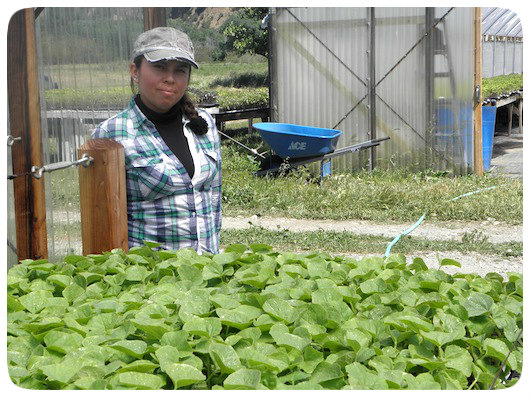Greenhouse Work
Years ago, when European lords and ladies were interested in botany and agriculture, greenhouses were elaborate, beautiful buildings covered with glass and full of complicated heating, cooling and lighting equipment. If these grand greenhouses at Kew Gardens or the Palace of Versailles form your image of a greenhouse, you might find the four Full Belly greenhouses to be plebeian, practical affairs, covered with plastic films and watered by hand with a garden hose. But despite their simplicity, these greenhouses and Ana Cervantes, our Greenhouse Manager, are unsung Full Belly Farm heroes.
Ana has worked at Full Belly for eight years. This year, she started cleaning and preparing the greenhouses for their busy season in early January, and by the middle of the month she was preparing trays and soil mix for the first planting of tomatoes, lettuce and broccoli. She explained to me that each tray can hold 200 plants and in one greenhouse there are almost 300 trays. Later, in the other greenhouses, she planted onions, leeks, melons and flowers. For each crop, there are several varieties. Lots of flower varieties are started in the greenhouse before being planted in the field: amobium, statice, lavender, asters, marigolds, globe amaranth, zinnias, and celosias. Luckily, we don’t have to sprinkle the seeds one by one into each cell of the tray – that’s how we used to do it! Now we use a vacuum seeder that distributes them fairly accurately.
Every morning Ana checks the temperature in all four greenhouses, takes off the plastic covering that goes directly over the plants to keep them warm at night, and checks to see how the plants are doing. It takes about 1/2 hour to water each greenhouse. If the day is really warm, the greenhouses will need water twice per day. There are plenty of other greenhouse chores to do as well. For example, the vacuum seeder sometimes puts more than one seed in each cell. This can be a good way of hedging your bets if the seeds don’t germinate well, but if they do, Ana will thin out the plants so that there is only one per cell. When the plants have their second leaves she fertilizes them with a bit of kelp and fish emulsion in the water.

Ana and some melon seedlings
I asked Ana if anything ever goes wrong. She answered that this year there have been no plant diseases, thank goodness and everything has gone well. She does have one small problem! There is a tray of Brandywine tomatoes, but clearly it contains two different kinds of tomatoes. Although most of the young tomatoes look the same, she can tell the difference between a few of them, including the Brandywines, and there are some unidentified tomatoes in one of the Brandywine trays.
There is going to be one more planting before the greenhouses are closed for the season. After that, Ana will join Don Celso’s crew of eight people picking cherry tomatoes. In the greenhouses, she feels that all the responsibility is hers and in contrast, when she works in the group the responsibility is shared. Although people might think that it is very hard to work in the summer heat, Ana says that she thinks it is beautiful to be outside. When she says this to Celso he replies that obviously her heart is content.
–Judith Redmond
